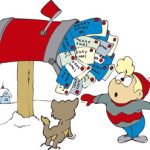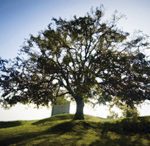For All of Us

Almost a decade ago the United Nations General Assembly set aside March 21 as International Day of Forests, a time to honor and raise awareness of the importance of forests, and trees in general. Some countries also celebrate Arbor Day or Love a Tree Day. In Mexico, that day is on the second Thursday in July, which this year occurs on July 14.
But I have always been in awe of trees, not just on one day of the year. Individual trees have been my sacred totems, nurturing me with deep moments of contemplation. Indeed, I worship trees in the sense of the original meaning of the word worship: to find worth; to find an adoring reverence or regard.
That is to say, I have had a deep relationship with trees, rather than thinking of them as mere things. In fact, I talk to them . . . and they talk to me! In contemplating this incredible gift of creation, I realize that trees have enriched my entire life. I have had lots of time to think about what is really important to me while I have sat under them, climbed them, planted them, pruned them, and swung right side up and upside down and sideways from them.
So it is about the spirits of the trees I write, and how when we human beings revere trees, we revere ourselves; and how when we malign trees, we malign our own spirits. Indeed, each tree is unique—each one has its own birthing and blossoming story, just like us. And each tree and human being will die, some tragically and needlessly.
*****
The sacredness of trees is deeply rooted in religious conceptualizations of early humanity. This concept is based on the fundamental idea of the unity of life in nature. The idea that groves of trees were sacred places can be traced back to the hunting and gathering people of the Paleolithic era. In ancient times, the worship of various trees was prevalent in Egypt, Arabia, Persia, Assyria, China, India, Ceylon, Rome, and Greece, among many other places. Indeed, throughout early Europe, nature—trees in particular—were reverenced.
The archetypal journey into shamanic knowledge taken by the Scandinavian god Odin includes his climbing a tree—The World Tree. This act allowed him to journey into deeper awareness, to a more profound state of consciousness, to a glimpse of the sacred. But Odin’s quest is not merely his own, because it symbolizes the universal experience of shamans in all cultures at all times. In effect, the tree symbolizes a ladder to another world, another state of being.
But with the coming of Christianity into northwestern Europe during the seventh century, conflict occurred with the indigenous spiritual beliefs and practices. One of the first churchmen to hold high political office in England, a fellow known simply as Edgar, demanded of the priesthood that they forbid such practices as necromancies, divinations, incantations, sacred circles, and tree worship.
Still, even today people around the world worship trees.
Some Indonesians believe that holy spirits reside in the banyan tree. Native Hawaiians have a similar concept. Various tribes in Africa strictly forbid the cutting down of trees and the hunting of animals within sacred groves. The Native American tribe, the Lakota, revere the cottonwood tree. It is used in their ritual Sundance, and is placed in the center of the dancing circle. Sun Dancers pray to the Great Spirit for blessings on all people.
*****
Of particular note for us who live in Mexico, is the Tule Tree, near Oaxaca City, MX. I have visited this sacred tree twice, and have always been in awe of it. This 2,000-year-old Montezuma cypress tree, El Arbol del Tule, is one of the oldest and largest trees in the world. It also is reported to be the widest tree in the world. Its existence is chronicled by the ancient Aztecs. Indigenous people of the area consider the tree sacred. According to Mixtec myth, humans originated from this and all cypress trees.
A crucial point to consider is the idea that the conservation of nature was enhanced due to this veneration for trees and plant life held by people throughout the world in ancient time and even today. But with that loss of a sacred perspective has come mass destruction of our forests, plants, and animals.
Tragically, the God of the Old Testament who instructed Adam to have dominion over the earth (meaning to be a caretaker) has been misinterpreted by people to mean domination over the earth. We no longer understand the wisdom of our forebears: their awareness of the interdependence of each aspect of nature.
But let metell you a personal story of how some people are attempting to return to this ancient teaching. Many years ago I was in Israel planting a tree in a section of a hillside garden named after Dr. Martin Luther King Jr. It was an emotional experience for me to realize that in that war-torn land, I was performing a symbolic act of peace in the name of a man who spoke for peace. It was a worshipful moment for me. Indeed, Israel is a land whose people are planting millions of trees, turning a desert into a forest. Each tree is symbolic of the renewal of life, and of the hope for peace. I planted a little oak tree in Israel that day. But hopefully “my tree” now provides a bit of shade and nurtures the land. I think of the hymn “Vine and Fig Tree” whose words speak of that hope for peace with these words: And ev’ry one ‘neath a vine and fig tree shall live in peace and be unafraid. Nevertheless, this adaptation of the words proclaimed by the Old Testament prophets Isaiah and Micah express a hope that has yet to be achieved.
Indeed, the idea of the tree is crucial to the symbolism of the biblical Creation story—and of its many interpretations down through time: And out of the ground made the Lord God to grow every tree that is pleasant to the sight, and good for food; the tree of life also in the midst of the garden, and the tree of knowledge of good and evil. But the story tells how Adam and Eve disobey God and eat of the Tree of Knowledge of Good and Evil, and are therefore cast out of the Garden, lest they also eat of the Tree of Life and live forever.
*****
How we have lost sight of the reverence for trees and nature in general, that humanity once had in abundance! Remember Joyce Kilmer’s poem: I think that I shall never see, a poem as lovely as a tree. But people have destroyed such “poems.” The fact is this: trees are dying. Born 500 million years ago, trees are in the midst of their death throes.
Consider these sad statistics:
*10,000 years ago, before agriculture, more than 15 billion acres worldwide were covered by forest. Today, barely 10 billion acres are forested.
*50 acres of rain forest are destroyed each minute. That’s about 27 million acres a year, an area equal in size to the state of Pennsylvania.
*40 percent of Central American rain forests have been converted into pastures for beef production, 90 percent of which is exported to the United States primarily for use in the fast food market or in pet food.
*2.8 billion trees are cut down in the world each year; the United States logs more than any other country, more than twice as much as Brazil.
*A 100-foot-tall tree provides the wood and paper products consumed annually by the average American.
*We require oxygen and produce carbon dioxide; trees and other plants require carbon dioxide and produce oxygen. Any significant loss in forested land directly affects the Earth’s atmosphere for other forms of life. By consuming carbon dioxide, trees mitigate the greenhouse effect.
Ogden Nash recasts Joyce Kilmer’s poem with these sadly relevant words:
I think that I shall never see
A billboard lovely as a tree.
Perhaps, unless the billboards fall,
I’ll never see a tree at all.
Well, imagine a planet as barren as the rocky moon: a dry and dusty place that once was called Earth. This bleak image is a possible reality within the next century or two! The majority of scientists tell us this. They predict that within a very short time we could kill off ourselves and all other animal and plant life. It is neither a horror of science fiction nor a prophecy from the Old Testament, but a scientific fact that humanity the consumer could become humanity the consumed.
The sea, land, and air around us interact with each other, and all life depends on this harmonious relationship. But along came humanity as homo faber (the toolmaker), claiming what was promised to us in the Garden of Eden: dominion over the earth. But didn’t that mean we were entrusted to be caretakers of the earth, not its executioners who poison the sea, destroy the land, and pollute the air?
I conclude my thoughts with another image of my trip to Israel: I am traveling on a tour bus when our guide points out that we are passing Mt. Arafat, the place where some believe Noah’s Ark was discovered. I think about that in relation to this essay of mine about my talking to trees. Certainly, Noah, of biblical fame, had a warning that the Flood was coming, and he believed it. He told others about their impending destruction. But they wouldn’t listen to him. So, Noah went into the more abundant forests of his day and found trees to build his Ark. We moderns have a warning of planetary destruction, too. But what are we doing about it? Not much, indeed. And if we do little or nothing to save our planet, there no longer will be trees left with which we can build our Ark.
It really is a matter of life and death for all of us!
- Lakeside Living – April 2024 - March 29, 2024
- THE FOOL WITHIN US - March 29, 2024
- Lakeside Living – March 2024 - February 29, 2024










Thank you so much Don Beaudreau for your wonderful, thought provoking article about the importance of trees. I love trees, in every house we lived I planted some, in this last one here in Riberas, I planted seven. Last year, when our most beautiful jacaranda tree died, my heart was broken: it was one of the reason we had bought the property. As the Tree Service company was taken it down, I was inspired to have its trunk turned into a sculpture. Our tree still lives as the good and bad dragons, a metaphor for the Ying/Yang we all have to contend with in our lives. I love the sculpture even if it is just a shadow of the grandeur and majesty of what was there before.